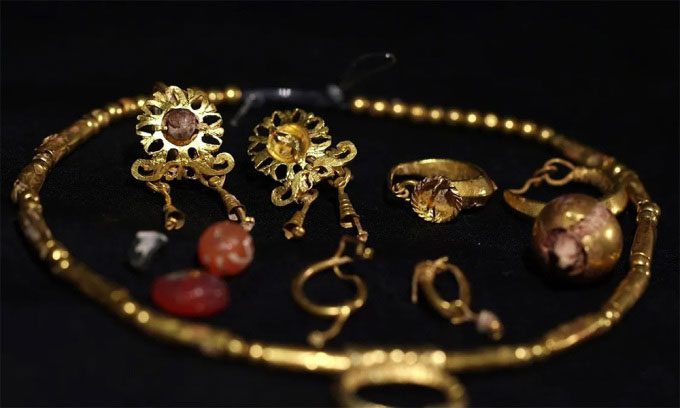Experts believe that exquisite jewelry such as gold earrings and gold pendants helps protect a girl in the afterlife.
An ancient gold jewelry set from a tomb near Jerusalem was displayed for the first time at the 48th Archaeological Congress organized by the Israel Antiquities Authority, the Israel Exploration Society, and the Israel Archaeological Society in Jerusalem on April 3. Discovered over 50 years ago, this jewelry had never been exhibited publicly until the congress.

1800-year-old gold jewelry set. (Photo: Emil Aladjem/Israel Antiquities Authority).
Adorned with the symbol of the Roman goddess Luna, this 1,800-year-old jewelry set was designed to ward off evil spirits and protect a young girl in the afterlife. The set includes gold earrings, a hairpin, a gold pendant, gold beads, carnelian stones, and glass beads.
Experts found these items in a lead coffin at a Roman burial site on the Scopus mountain, northeast of Jerusalem, in 1971. It appears that relatives placed these exquisite items beside the young girl’s body, or she may have been wearing the jewelry when she was buried.
The jewelry provides scientists with insight into the period when this region was under Roman rule. For over a century, from 6 to 132 AD, this area was known as the Roman province of Judea. This period also included significant events such as the crucifixion of Jesus Christ and the emergence of Christianity.
The Roman rule ended in chaos and bloodshed, yet its cultural influence remains. The jewelry in Jerusalem is one of the pieces of evidence that demonstrate this. Some items, such as a necklace with a crescent moon pendant, bear the symbol of Luna – the Roman goddess of the Moon.
The historical context of the tomb suggests it may have been the burial site for newcomers to the city. They arrived from other parts of the Roman Empire and did not follow Christianity. Researchers believe that the jewelry was likely buried alongside the deceased to protect them from malevolent spirits disturbing them in the afterlife.


















































